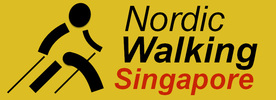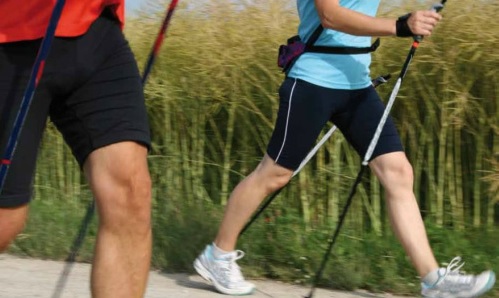|
Health facts - Benefits of Nordic Walking
1. Burn more calories in less time Consumes approximately 400 calories per hour (compared with 280 calories per hour for normal walking). Energy consumption increases when using poles by an average of 20% compared with ordinary walking at the same speed without poles. Heart rate is 5-17 beats per minute higher. Up to a 46% increase in energy consumption when fully utilising the correct technique (Cooper Institute research, Research Quarterly for Exercise and Sports 2002 publication). |
2. Low rate of perceived exertion & easy to master
You can walk for extended periods and not feel exhausted because, you are utilising more of your body's muscle groups to propel you.
3. A total body activity
The lateral mobility of the neck and spine increases significantly.
The muscles most actively involved are the forearm extensor and flexor muscles, biceps, triceps, the rear part of the shoulder muscles, the large pectoral muscles, chest, abdominals, back muscles, and your butt!
4. Reduced load and relaxed muscles
- Reduces the load on knees and other joints
- Improves balance and co-ordination
- Releases pain and muscle tension in the neck/shoulder region
- Poles are a safety factor on slippery surfaces
5. Varied levels of intensity
6. Energetic, Relaxing and Fun
The Ministry of Health and SPARC recommend that all adults get at least 30 minutes of activity five or more days per week, and Nordic Walking is the ideal way to do so. This low impact, total-body movement is easy and effective - and so fun you'll likely want to do more than the 30 minutes minimum. And if you want to boost the intensity for greater calorie burn and improved fitness you can simply pole harder, tackle more challenging terrain or walk for a longer time with a low level of perceived exertion.
The complete Cooper Institute study can be found at this reference: Timothy S. Church et. al. Field testing of Physiological Responses Associated with Nordic Walking. Research Quarterly for Exercise and Sport, vol. 73, No. 3., pp 296-300
You can walk for extended periods and not feel exhausted because, you are utilising more of your body's muscle groups to propel you.
3. A total body activity
The lateral mobility of the neck and spine increases significantly.
The muscles most actively involved are the forearm extensor and flexor muscles, biceps, triceps, the rear part of the shoulder muscles, the large pectoral muscles, chest, abdominals, back muscles, and your butt!
4. Reduced load and relaxed muscles
- Reduces the load on knees and other joints
- Improves balance and co-ordination
- Releases pain and muscle tension in the neck/shoulder region
- Poles are a safety factor on slippery surfaces
5. Varied levels of intensity
6. Energetic, Relaxing and Fun
The Ministry of Health and SPARC recommend that all adults get at least 30 minutes of activity five or more days per week, and Nordic Walking is the ideal way to do so. This low impact, total-body movement is easy and effective - and so fun you'll likely want to do more than the 30 minutes minimum. And if you want to boost the intensity for greater calorie burn and improved fitness you can simply pole harder, tackle more challenging terrain or walk for a longer time with a low level of perceived exertion.
The complete Cooper Institute study can be found at this reference: Timothy S. Church et. al. Field testing of Physiological Responses Associated with Nordic Walking. Research Quarterly for Exercise and Sport, vol. 73, No. 3., pp 296-300
History of Nordic Walking
1990s: Nordic Walking poles were first documented to be used by Finnish cross-country skiers for their summer training. The key person in launching and promoting Nordic Walking in Finland is Tuomo Jantunen - Suomen Latu.
1997: The explosion of Nordic Walking really began
1999: Nordic Walking was introduced in Switzerland, then in Germany and Austria.
2003: The number of participants in Nordic Walking worldwide doubled from one million to over two million
Now: Nordic Walking is now a growing trend in various parts of the world
1990s: Nordic Walking poles were first documented to be used by Finnish cross-country skiers for their summer training. The key person in launching and promoting Nordic Walking in Finland is Tuomo Jantunen - Suomen Latu.
1997: The explosion of Nordic Walking really began
1999: Nordic Walking was introduced in Switzerland, then in Germany and Austria.
2003: The number of participants in Nordic Walking worldwide doubled from one million to over two million
Now: Nordic Walking is now a growing trend in various parts of the world

